The world of art has undergone a profound transformation with the rise of NFTs (Non-Fungible Tokens), providing artists with a groundbreaking platform to exhibit and exchange their digital creations. However, as the allure of NFTs continues to expand, a darker undercurrent has also emerged—deceptive practices and exploitative maneuvers targeting both creators and buyers. In this article, we delve into critical insights and precautionary steps that every NFT artist should take to ensure their safety and security.
Temptation and Persuasion
The mesmerizing universe of NFTs has captured the imagination of artists and collectors alike, offering a trailblazing and distinctive method to trade digital art using the innovative technology of blockchain. As artists proudly present their NFTs on renowned platforms, they might unknowingly beckon not only admirers but also individuals harboring motives beyond sincere admiration. The allure of quick financial gains, accompanied by the shroud of anonymity inherent to the online landscape, sets the stage for NFT artists to become susceptible to various astute tactics employed by particular parties. This intersection of genuine interest and potentially misleading intentions unveils a scenario where vigilance stands as a critical shield. The irresistible pull of immediate monetary rewards interwoven with the enigmatic essence of the digital realm reinforces the significance of measured contemplation.
Red Flags: Identifying Suspicious Buyers
A frequently seen trick includes scammers acting like they're really interested in buying an artist's NFTs. These scammers might pretend to be a buyer who wants to get multiple NFTs and is willing to pay way more money than these artworks usually go for. Imagine they say something like, "I'll give you 8 ETH for each piece!" This big offer is meant to catch the artist's attention and make them excited about the deal. But then, things take a shady turn. The scammer will ask the artist to share their wallet address. This might seem harmless, but it's a part of their plan to trick the artist. It's like they're luring the artist into a trap with the promise of a good deal, only to use their wallet information against them. So, artists need to be careful and double-check everything before sharing any personal info online.
Here's where the red flags emerge:
-
Overly Generous Offers: Exercise discernment when encountering offers that appear remarkably lucrative, potentially diverging from the prevailing market valuations. These disproportionately advantageous propositions might warrant additional investigation.
-
Profiles Lacking Verification: Take heed of individuals seeking transactions without verified profiles, particularly if their history on the platform or their broader digital footprint is limited or absent. A verifiable background is an important indicator of trustworthiness.
-
Unconventional Payment Requests: Approach with caution if you are asked to engage with unconventional or obscure payment methods, especially those that are less traceable. Established, secure methods are typically preferred in genuine transactions.
-
Attention to Letter Case: Fraudsters might furnish a wallet address that seems accurate, yet exhibits slight variations in the capitalization of alphanumeric characters. It's crucial to remember that wallet addresses are case-sensitive. Therefore, it's prudent to meticulously review the supplied address, character by character.
-
Confirmation Requests: Scammers might ask for your confirmation before proceeding with the transaction. Be cautious if they ask you to confirm your wallet address via email or through a message on a platform.
-
Urgency: Scammers might insist on immediate action, creating a sense of urgency to pressure you into making hasty decisions. Always take your time to verify before proceeding.
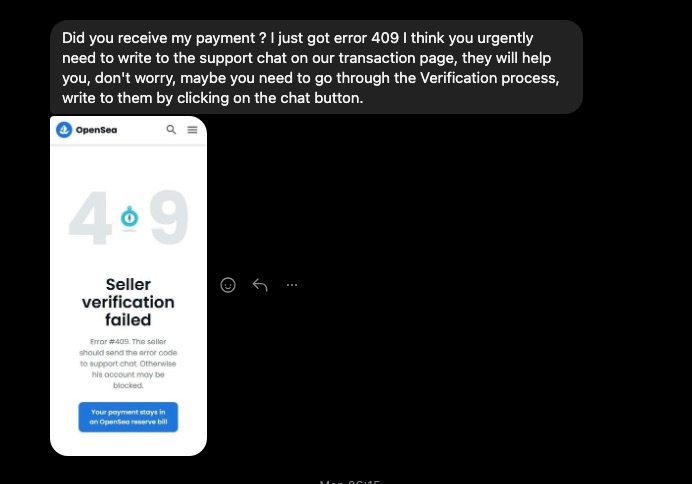
The "Error" and Support Request
After you've provided your wallet address, scammers may claim that they've encountered an error or issue during the transaction. They will then ask you to urgently contact a "support" email or scan a QR code leading to a supposed support site (Refer to Figures below).
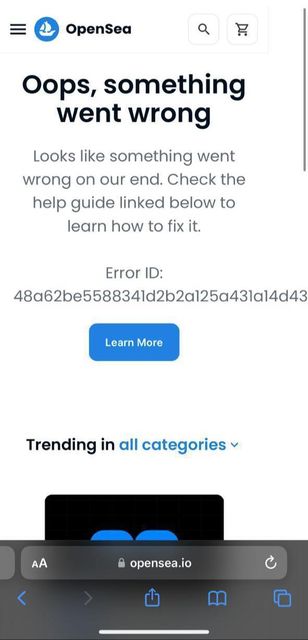
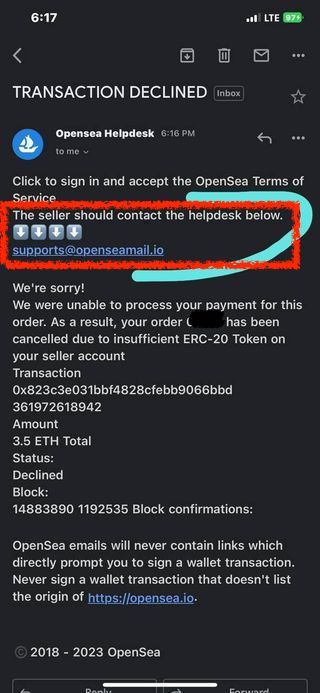
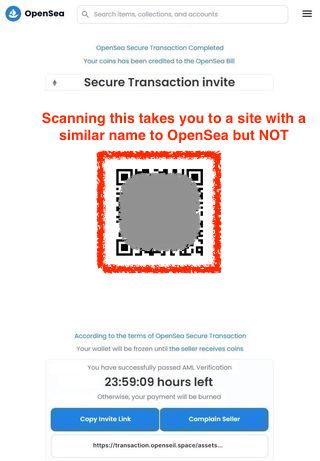
Here is a sample of one response received when the author contacted OpenSea directly via OpenSea Help Center Contact Us (note: the email address from the response received is NOT as written in the screenshot above).
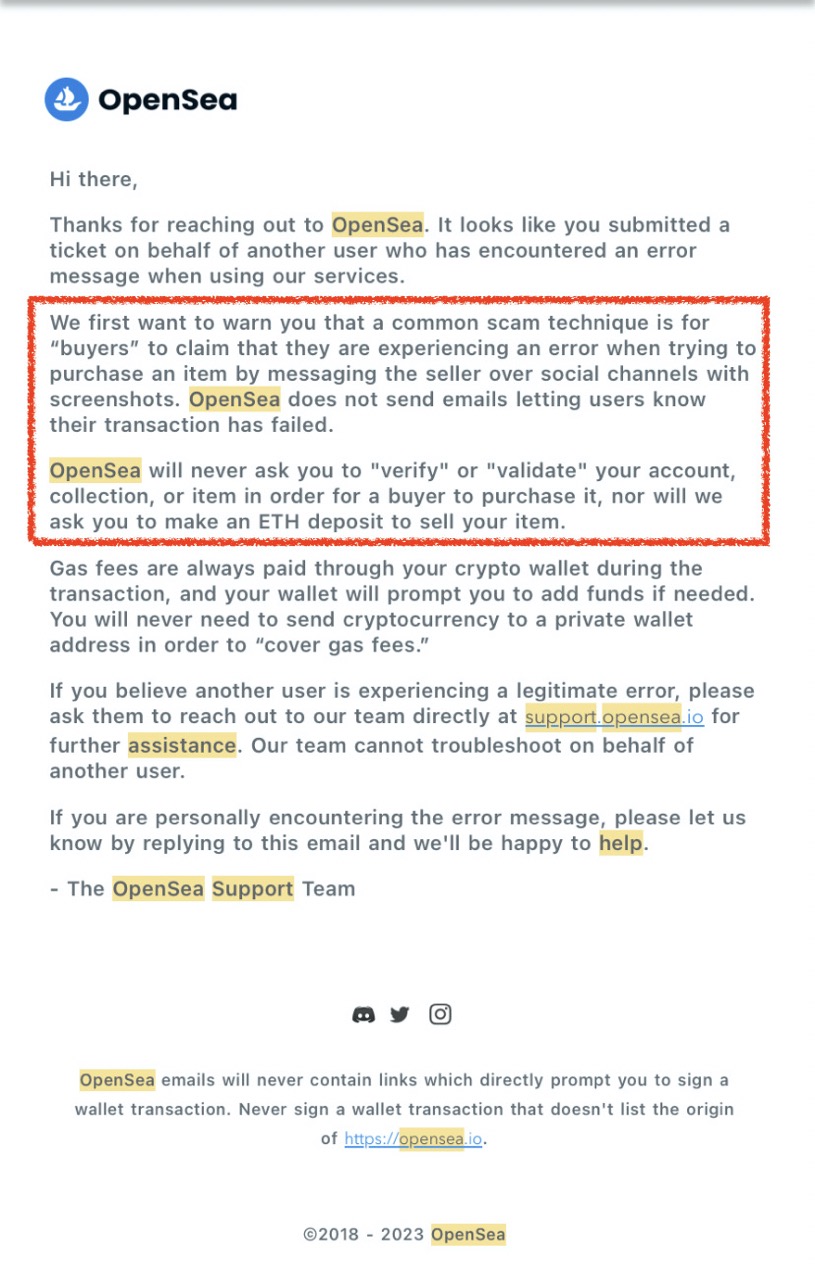
As for scanning QR code to validate the transaction. Please consider the screenshot below obtained from the Metamask Community Forum, response from Chinzilla:
 Credit: Metamask Community Forum
Credit: Metamask Community Forum
Support Page for Metamask: https://support.metamask.io/hc/en-us
Protecting Yourself: Tips for Artists
-
Research Platforms: List your NFTs on reputable, well-known platforms with a strong track record of security and customer service. Avoid lesser-known platforms that may lack robust security measures.
-
Verify Transactions: Always double-check wallet addresses, ensuring that they match perfectly. Even a minor variation in case can indicate a scam.
-
Avoid Urgency: Scammers often create urgency to push you into making rash decisions. Take your time to thoroughly assess the situation.
-
Use Official Channels: If you encounter any issues, contact the platform's official customer support through their verified channels, not through the contact information provided by the potential buyer.
-
Educate Yourself: Familiarize yourself with common scam tactics and stay updated on new techniques scammers might use.
-
Use Escrow Services: When dealing with high-value transactions, consider using escrow services offered by some NFT platforms. These services help ensure a secure transaction for both parties.
Here's how it generally works:
-
Listing and Agreement: The seller lists their NFT for sale, and the buyer expresses interest in purchasing it. They agree on the terms of the transaction, including the price and any other conditions.
-
Escrow Holding: The agreed-upon payment is held in escrow by the platform. This means that the funds are securely held by a neutral third party (the escrow service) until the terms of the transaction are fulfilled.
-
Confirmation of NFT Ownership: The seller confirms the ownership of the NFT and its details on the platform.
-
Buyer's Payment: The buyer sends the agreed-upon payment to the escrow service.
-
Transfer of NFT: Once the payment is verified and secured in escrow, the seller transfers the NFT to the buyer.
-
Release of Funds: Upon the successful transfer of the NFT, the escrow service releases the payment to the seller. This confirms that the NFT has been received by the buyer and the seller gets their payment.
Escrow services add an extra layer of security to NFT transactions, helping to prevent common scams where one party doesn't fulfill their end of the bargain. However, it's important to note that scammers might also try to create fake escrow services or manipulate the process. Therefore, it's essential to use reputable and well-established NFT platforms that provide legitimate escrow services to ensure a safe transaction.
In the dynamic world of NFTs, staying vigilant and informed is paramount. By understanding the tactics scammers employ and adopting prudent practices, NFT artists can protect their creations, their reputation, and their financial well-being. As the NFT landscape evolves, remember that a cautious approach is the key to safely navigating this exciting new frontier of art and technology.